2. 中国科学院大学资源与环境学院, 北京 100049
2. College of Resources and Environment, University of Chinese Academy of Sciences, Beijing 100049, China
近年来地下水中硝态氮污染成为全球性水环境问题[1, 2].硝态氮是水中氮的主要化学物质, 参与环境中的化学和生物反应.硝态氮自然存在于环境中, 但地下水中的硝态氮质量浓度超过自然水平, 可能对人类健康产生潜在的危害, 例如先天缺陷, 消化道疾病和免疫系统损害等[3~5].含水层的自净能力有限, 污染物残留在含水层中容易造成持续化问题[6].尤其在农业区, 由于肥料的过度或不合理使用, 盈余的氮素在土壤中积累, 通过不同径流途径流失进入到地表水体和地下水体, 导致地表水体富营养化和地下水硝态氮污染等系列水环境问题[7, 8].
我国许多地区均已发现地下水硝态氮污染问题且呈日益严重趋势.周迅等[9]对福建省晋江市浅层地下水中的硝态氮质量浓度进行了调查, 结果表明硝态氮质量浓度在4.43~216.91mg ·L-1之间, 平均值高达78.91mg ·L-1, 超过地下水质量Ⅲ类标准的样点占41.51%.北京南部以及河北省325个浅层地下水中硝态氮超标率达到18%[10].滇池流域由于农业集约化程度高, 地下水中硝态氮质量浓度平均值高达26.93mg ·L-1, 最高值达到326mg ·L-1, 严重超标率高达34.14%[11].已有研究表明, 导致地下水硝态氮污染因素主要有地形地貌、地下水埋深、土壤结构等自然因素和土地利用及其管理强度等人为因素, 而这些因素相互作用、机制复杂[12~18].
长江上游山地丘陵区主要是以分散小口径浅井开采为主的“庭院式自来水”供水模式, 农业集约化程度较高、氮肥施用量大, 地表水体富营养化严重[19], 生活饮用水极易遭受污染, 而关于该区地下水硝态氮空间分布及其影响因素相关研究较少.因此, 本文选取长江上游山地丘陵区典型农业小流域, 结合农业小流域的自然地理条件和水文地质背景特征, 综合分析浅层地下水中硝态氮质量浓度现状、时空分布特征及其影响因素, 以期为评价和分析该区地下水硝态氮污染风险和饮用水安全提供理论依据.
1 材料与方法 1.1 研究区概况 1.1.1 自然地理位置与气象水文本研究小流域位于长江上游四川盆地中部偏北的绵阳市盐亭县林山乡, 流域面积约为4 km2, 嵌套3个子流域, 分别为苏荣集水区、截留小流域和大兴小流域.距离成都约180 km, 位于绵阳市东部70 km处, 西邻三台县, 东靠阆中市, 北与梓潼县接壤, 南与射洪县相连, 属典型山地丘陵区农业小流域.
研究区属于亚热带湿润季风气候区, 具有日照少, 多云雾, 霜期短, 风速小的特点.年平均降雨量约为946 mm, 最大年降水量达到1 515 mm, 最小年降水量为494.5 mm, 一年降雨中夏季占比最高, 为65.5%, 春季占比最低, 为5.9%[20], 丰水期为5~9月, 枯水期为11月~次年2月.历年平均气温16.4℃, 平均蒸发量为630 mm, 年均湿度78%, 无霜期为293 d, 年均日照时长达到1 104 h.
1.1.2 地质与水文地质条件研究区北部有较多的深山, 南部有较浅的丘陵, 地势北、北东高, 南西低, 土壤主要是由白垩系和侏罗系紫色砂页岩发育而成的紫色土, 是典型的紫色土低山丘陵农耕区.研究区位于一连环式旋钮构造体系上, 主要穿过第四系、白垩系和侏罗系的地层, 第四系不整合或假整合在白垩系和侏罗系之上, 岩层产状平缓, 褶皱宽缓无大断裂, 地层分布如图 1.

|
图 1 研究区地质情况 Fig. 1 Geological map of the study area |
地下水类型有第四系孔隙潜水、砂-泥岩风化带孔隙-裂隙水和砂-泥岩层间裂隙水, 以风化裂隙水为主.补给区为北部低山沟谷区, 排泄区为南部浅丘平原地带, 地下水流向大致由北向南, 地层颗粒由北至南逐渐变细, 地下水埋深逐渐变浅.主要补给来源为大气降水、农灌水、河渠水以及部分砂砾岩段的局部补给, 地下水的径流途径短, 循环交替积极, 排泄方式主要为人工抽水、径流排泄及蒸发.
1.2 样品的采集每个子流域平均布设4个浅层地下水取样点, 且主要分布在该区域的耕地、林地和居民区这3种土地类型上, 共设置了11处取样点(采样点分布状况见图 2, 监测井基本情况见表 1).采样频次为每月3次, 共进行连续1 a的观测研究.每个取样点利用抽水泵外接取样器进行取样, 并记录井径埋深等信息, 取样深度在30~50 cm之间, 取样前用去离子水润洗瓶子3遍, 每次采集500 mL水样于聚乙烯塑料瓶中, 采集完成后置于4℃恒温箱中保存, 并于当天送至实验室进行测试分析.

|
图 2 研究区采样点分布示意 Fig. 2 Distribution of sampling points in the study area |
|
|
表 1 研究区监测井基本情况表 Table 1 Basic conditions of monitoring wells in the study area |
1.3 测试方法
浅层地下水pH采用pH计(S220-B, 瑞士)进行现场测试, 精度为±0.1.水样中水溶性离子(Ca2+、Mg2+、K+、Na+、CO32-、HCO3-、Cl-、SO42-、PO43-和NO3-)通过0.45 μm滤膜过滤, 采用美国戴安的离子色谱仪(ICS900)测定阴阳离子质量浓度.水样中的TN、NO2--N和NH4+-N测定方法根据文献[21]中的规定, 用紫外分光光度计(UV-8500, 日本岛津)进行测定.利用小流域内自动气象观测站(MAWA301, 芬兰Vasaila公司)获取降雨等气象数据.
1.4 数据处理与统计分析采用《地下水质量标准》(GB/T 14848-2017)和《生活饮用水卫生标准》(GB 5749-2006)评价地下水质量.运用SPSS 22.0软件(IBM公司, 美国)对NO3--N质量浓度与地下水埋深、月平均降雨量进行了二元回归分析, 对NO3--N质量浓度和地下水化学因子进行了Pearson相关性分析, 利用Aquachem 4.0(Waterloo Hydrogeologic公司, 加拿大)绘制Piper三线图, 表示区域水化学特征.通过Origin 9.1(Origin Lab公司, 美国)绘图软件作出各图件.
2 结果与讨论 2.1 地下水化学特征研究区的地下水化学成分组成如表 2所示.区域内浅层地下水主要阴离子为HCO3-和SO42-, 主要阳离子为Ca2+, 对研究区地下水化学类型按舒卡列夫分类, 可以得出水化学类型为HCO3 ·SO4-Ca, 地下水水化学Piper三线图如图 3所示.研究区地下水主要赋存于孔隙和裂隙中, 而裂隙水的主要含水层由钙质砂岩组成, 同时在水岩的相互作用下, 方解石和长石溶解于水, 导致地下水中HCO3-和Ca2+质量浓度较高, Mg2+和SO42-的来源主要与研究区下伏基岩侏罗系地层中含有石膏薄层有关.
|
|
表 2 研究区浅层地下水化学统计数据 Table 2 Chemical statistics of shallow groundwater in the study area |
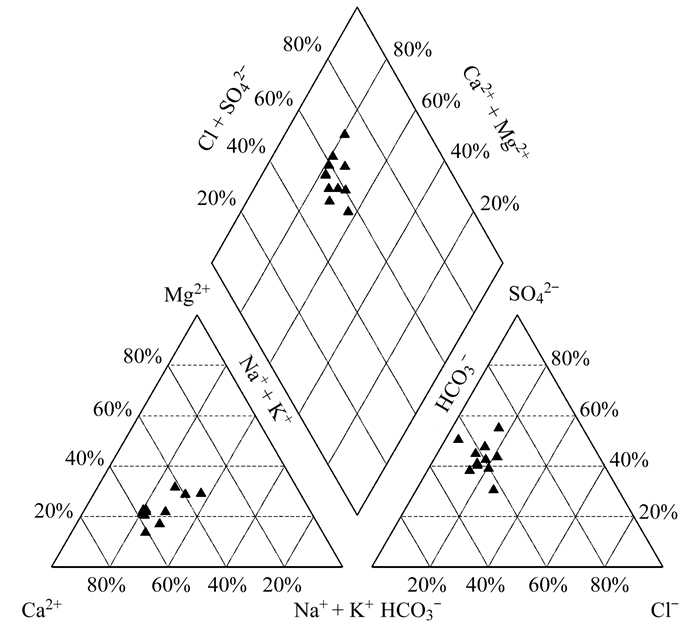
|
图 3 浅层地下水水化学成分的Piper三线图 Fig. 3 Piper diagram showing hydrochemical composition of shallow groundwater |
通过对小流域浅层地下水三氮(NO3--N、NH4+-N和NO2--N)质量浓度及其占总氮(TN)比例的连续观测研究(表 3), 发现TN质量浓度变化范围为1.65~14.28 mg ·L-1(均值:7.74mg ·L-1).NO3--N质量浓度在0.40~12.51 mg ·L-1之间变化(均值:6.66 mg ·L-1), 约27%的地下水NO3--N质量浓度超过国家生活饮用水卫生标准[22](10 mg ·L-1), NO3--N质量浓度占TN质量浓度的24.32% ~96.97%.地下水的NH4+-N质量浓度和NO2--N质量浓度范围分别为0.03~0.09 mg ·L-1和0.00~0.02 mg ·L-1, 均未超标.总体而言该农业小流域浅层地下水氮素以NO3--N为主, NH4+-N次之, NO2--N最少.
|
|
表 3 浅层地下水中主要形态氮年平均质量浓度及其占总氮比例1) Table 3 Annual average concentration of main morphological nitrogen and its proportion in total nitrogen in shallow groundwater |
不同空间位置浅层地下水NO3- -N质量浓度的频率分布如图 4所示.研究区的Ⅰ类、Ⅱ类和Ⅲ类水平均占比18.18%、18.18%和63.64%.其中, S2、S3、S5、S9和S11中Ⅲ类水分布频率达到100%.S8和S4中Ⅰ类水占比分别为100%和91.7%, 水质较好.S1、S7、S10和S6虽然超标率不高, 但Ⅲ类水占比分别达到83.3%、75.0%、33.3%和16.7%.从总体上看, 研究区地下水NO3--N质量浓度处于较低水平, 但从Ⅲ类水的分布频率(63.64%)来看, 存在向Ⅳ类水发展的潜在风险.
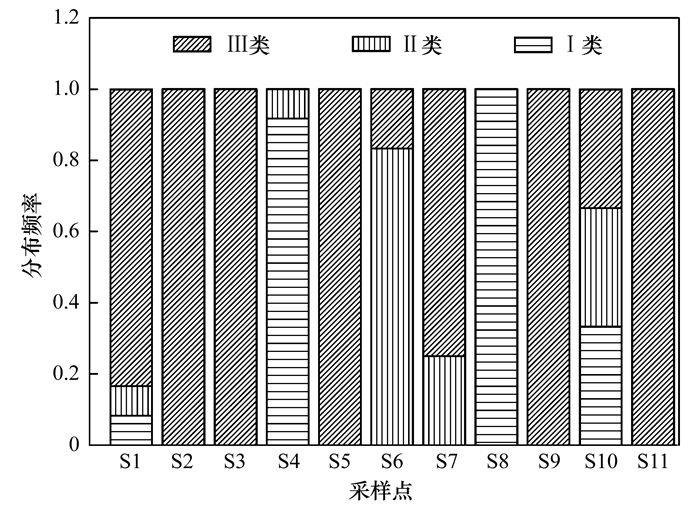
|
图 4 不同地区3类水的分布频率 Fig. 4 Distribution frequencies of three types of water in different regions |
本研究的农业小流域浅层地下水NO3--N质量浓度年内变化曲线如图 5所示.地下水中NO3--N的平均质量浓度在5.37~7.30 mg ·L-1之间变化, 年内变化呈现出一定的波动性.丰水期和枯水期NO3--N平均质量浓度分别为6.73 mg ·L-1和6.28 mg ·L-1, 浅层地下水NO3--N质量浓度呈现出丰水期总体高于枯水期的时间变异特征.
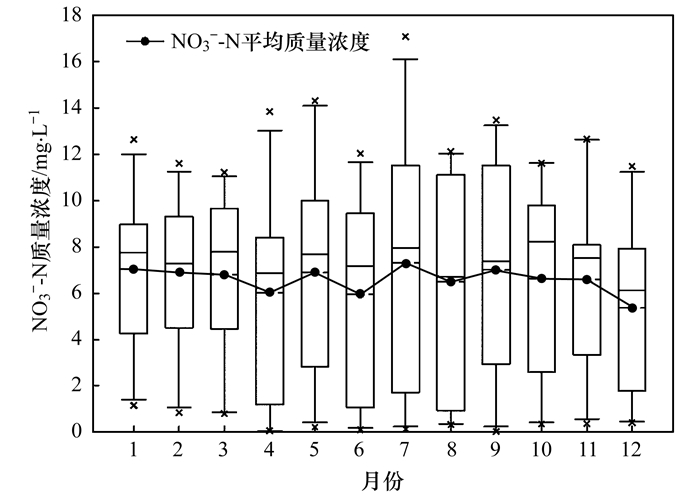
|
图 5 浅层地下水中NO3--N质量浓度的年内变化曲线 Fig. 5 Annual variation curve of nitrate concentration in shallow groundwater |
不同子流域间NO3--N质量浓度如表 4所示.地下水NO3--N平均质量浓度依次为截留(6.58 mg ·L-1)>大兴(6.34 mg ·L-1)>苏荣(5.20 mg ·L-1), 其中, 大兴子流域超标率最高, 达到50%.前人研究表明, 水井周围的环境条件、地下水埋深、地层结构和土地利用格局等均会影响地下水中NO3--N质量浓度[3, 23, 24].截留子流域农地比重大(55%), 居民点较为密集, 农业活动是导致该地区地下水NO3--N质量浓度升高的主要因素.大兴子流域包气带颗粒粗, 含水层透水性强, 所对应的活动区农业生产发达, 氮肥施用量较大, 导致NO3--N在土壤中的严重积累, 进而淋滤迁移到地下水[25].
|
|
表 4 不同子流域浅层地下水NO3--N质量浓度分析 Table 4 Analysis of nitrate concentration in shallow groundwater among different small watersheds |
其中, 截留子流域S2中NO3--N质量浓度最高, 达到12.51 mg ·L-1, S2埋深约1.76 m, 附近砂岩构造裂隙发育, 加之距离生活排污口较近, 导致NO3--N极易通过孔隙裂隙进入地下水, 使井水中NO3--N质量浓度增加.大兴子流域中S9和S8位置相近, 埋深分别为0.36 m和0.23 m, 但NO3--N质量浓度差异明显, 分别为10.49 mg ·L-1和0.40 mg ·L-1.可能是由于附近的储水空间由溶孔裂隙、浅层风化裂隙和层面裂隙组成, 富水性极不均匀, S9附近泥岩溶孔裂隙较为发育, 且该井使用年限达到20 a, 距离居民点排污口10 m, 左侧2 m处为碎石堆积而成的机耕道基座, 裂隙空间较大, 容易受到四周污染.
2.4 影响因素 2.4.1 地下水埋深研究区浅层地下水埋深普遍在0~5 m之间, 地下水NO3--N质量浓度随埋深而逐渐增加, 在2.5 m附近达到峰值后开始降低(图 6).埋深为0~2.5 m的地下水主要分布在第四系松散堆积物和白垩系夹关组地层中, 包气带颗粒粗, 含水层透水性好, 地下径流交替强, 土壤中的NO3--N不断下渗, 同时周围河流、农田中的NO3--N通过侧向扩散作用进入地下水, 在2.5 m附近达到最大值[26, 27].地下水埋深为2.5~5 m时, 与地下水NO3--N质量浓度呈反相关, 附近地层岩性主要为泥岩与砂质泥岩互层, 透水性差, 底层含氧量降低易形成还原环境, 导致NO3--N在厌氧微生物的作用下转换为气态氮化物和氮气[28~30].
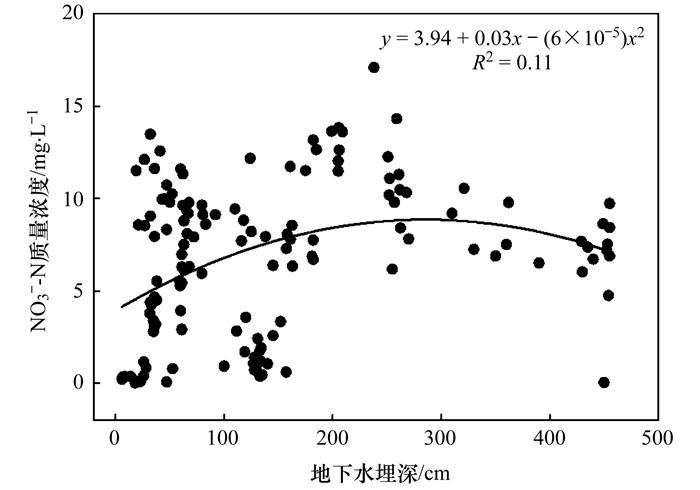
|
图 6 NO3--N质量浓度与地下水埋深关系 Fig. 6 Relationship between nitrate concentration and groundwater depth |
降雨不仅是影响可溶性氮垂直迁移的主要驱动因素, 也是浅层地下水的主要补给来源[31, 32].研究区降雨量与浅层地下水NO3--N质量浓度呈正相关(P<0.05), 如图 7所示.这是由于丰水期间该地区正处于施肥期, 随着降雨量的增加, 土壤肥料中的氮素在降雨驱动下淋溶流失进入浅层地下水[33, 34], 另一方面气温和溶解氧等水体条件在该时段更有利于硝化反应发生, 而在枯水期时, 小流域壤中流和地下径流发生频率低, 流失进入浅层地下水NO3--N减少[35], 导致地下水NO3--N质量浓度对降雨有直接响应关系.总体而言, 降雨、施肥事件及其相互耦合作用是研究区农业小流域浅层地下水NO3--N质量浓度时空变异特征的重要驱动因素.
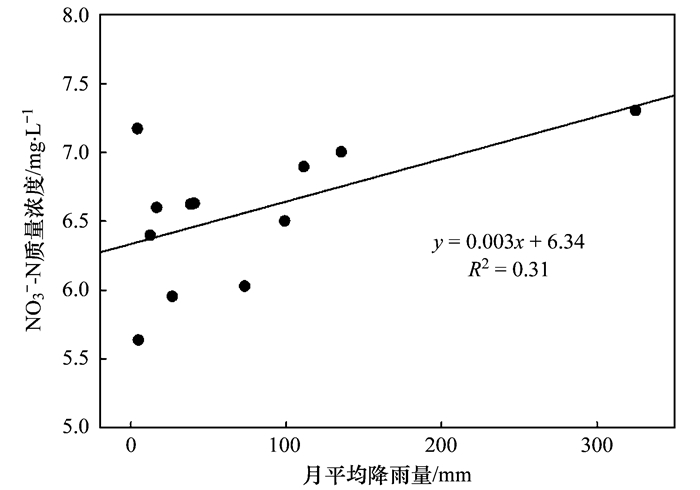
|
图 7 浅层地下水中NO3--N质量浓度与月平均降雨量的关系 Fig. 7 Relationships of nitrate concentration in shallow groundwater with the rainfall |
研究农业小流域浅层地下水三氮质量浓度与Cl-等其它化学因子相关关系如表 5所示.
|
|
表 5 “三氮”与地下水化学因子的相关性分析1) Table 5 Correlation analysis between tri-nitrogen and groundwater chemical factors |
浅层地下水NO3--N质量浓度与NH4+-N、DOC和SO42-质量浓度呈正相关, 与pH值呈负相关.研究区为农业小流域, 农田土壤NH4+-N质量浓度高, 极易随地表径流和壤中流等径流途径进入浅层地下水, 浅层地下水中NH4+-N在微生物作用下(DOC可为硝化作用提供碳源)发生硝化作用, 导致NO3--N质量浓度的增加.NO3--N与SO42-之间显著正相关关系可能是因为施用肥料中含有N和S元素, 施肥后土壤中的SO42与NO3--N同步流失进入浅层地下水, 这与贾小妨等[36]的研究结果一致.然而, 刘建奎等[37]和韩宇平等[38]的研究显示pH值范围为6.40~7.90时, 硝化作用最强, 但随着pH升高可能抑制硝化细菌的活性、减缓硝化作用, 导致地下水NH4+-N质量浓度升高, NO3--N质量浓度降低.该研究小流域浅层地下水pH平均值为8.08, 超过利于浅层地下水硝化作用发生的pH阈值, 这可能是小流域浅层地下水中NO3--N质量浓度与pH值呈负相关关系的重要原因.
Cl-作为保守的阴离子, 不与周围地下水发生化学反应, 通常认为地下水中的氯离子主要是由人类活动直接或间接输入[39].研究区农业小流域浅层地下水NO3--N与Cl-质量浓度间正相关关系表明, 该地区NO3--N主要来源于小流域内居民点含氮生活污水排放等人为活动, 该结果与万镇嘉[40]对陕西关中盆地农业区域浅层地下水NO3--N来源的研究结果一致.
3 结论(1) 长江上游山地农业小流域浅层地下水中NO3--N是氮素主要形态, 其质量浓度变化范围为0.40~12.51 mg ·L-1且超标率近30%.以NO3--N质量浓度为评价因子, Ⅲ类水质占比达63.64%, 存在向Ⅳ类水发展的潜在威胁, 应通过长期监测系统防止饮用水质的进一步恶化.
(2) NO3--N质量浓度呈现出时空变异特征, 丰水期NO3--N质量浓度(6.73 mg ·L-1)总体高于枯水期(6.28mg ·L-1); 坡耕地和居民区集中分布的截留和大兴子流域中地下水NO3--N质量浓度(截留子流域:6.58mg ·L-1; 大兴子流域:6.34 mg ·L-1)高于苏荣子流域(5.20 mg ·L-1).
(3) 研究区地下水中NO3--N质量浓度变化主要受地下水埋深、降雨、地下水化学因子影响, 其次与土地利用格局、管理强度和地层结构有关.在该农业小流域未来的发展建设中, 合理地土地利用与管理强度对实现区域内地下水的可持续利用至关重要.
| [1] | Chen J, Qian H, Wu H. Nitrogen contamination in groundwater in an agricultural region along the New Silk Road, northwest China:distribution and factors controlling its fate[J]. Environmental Science and Pollution Research, 2017, 24(15): 13154-13167. DOI:10.1007/s11356-017-8881-0 |
| [2] | Ayub R, Messier K P, Serre M L, et al. Non-point source evaluation of groundwater nitrate contamination from agriculture under geologic uncertainty[J]. Stochastic Environmental Research and Risk Assessment, 2019, 33(4-6): 939-956. DOI:10.1007/s00477-019-01669-z |
| [3] | Wagh V M, Panaskar D B, Mukate S V, et al. Nitrate associated health risks from groundwater of Kadava River Basin Nashik, Maharashtra, India[J]. Human and Ecological Risk Assessment:An International Journal, 2020, 26(3): 654-672. DOI:10.1080/10807039.2018.1528861 |
| [4] | Li Y Q, Wang F, Yan W J, et al. Enhanced nitrogen imbalances in agroecosystems driven by changing cropping systems in a coastal area of eastern China:from field to watershed scale[J]. Environmental Science:Processes & Impacts, 2019, 21(9): 1532-1548. |
| [5] | Johnson P T J, Townsend A R, Cleveland C C, et al. Linking environmental nutrient enrichment and disease emergence in humans and wildlife[J]. Ecological Applications, 2010, 20(1): 16-29. |
| [6] | Du Y, Deng Y M, Ma T, et al. Spatial variability of nitrate and ammonium in pleistocene aquifer of central Yangtze River basin[J]. Groundwater, 2020, 58(1): 110-118. DOI:10.1111/gwat.12888 |
| [7] | Eickhout B, Bouwman A F, van Zeijts H. The role of nitrogen in world food production and environmental sustainability[J]. Agriculture, Ecosystems & Environment, 2006, 116(1-2): 4-14. |
| [8] | Sabo R D, Clark C M, Bash J, et al. Decadal shift in nitrogen inputs and fluxes across the contiguous United States:2002-2012[J]. Journal of Geophysical Research:Biogeosciences, 2019, 124(10): 3104-3124. DOI:10.1029/2019JG005110 |
| [9] |
周迅, 朱春芳. 福建省晋江市浅层地下水硝酸盐含量特征及其水化学指示意义[J]. 地球学报, 2014, 35(2): 177-182. Zhou X, Zhu C F. The nitrate content characteristics of shallow groundwater in Jinjiang City, Fujian Province, and their hydrochemical indication significance[J]. Acta Geoscientica Sinica, 2014, 35(2): 177-182. |
| [10] |
王仕琴, 郑文波, 孔晓乐. 华北农区浅层地下水硝酸盐分布特征及其空间差异性[J]. 中国生态农业学报, 2018, 26(10): 1476-1482. Wang S Q, Zheng W B, Kong X L. Spatial distribution characteristics of nitrate in shallow groundwater of the agricultural area of the North China Plain[J]. Chinese Journal of Eco-Agriculture, 2018, 26(10): 1476-1482. |
| [11] |
黄强盛, 李清光, 卢玮琦, 等. 滇池流域地下水、河水硝酸盐污染及来源[J]. 地球与环境, 2014, 42(5): 589-596. Huang Q S, Ling Q G, Lu W Q, et al. Characteristics and potential sources of nitrate pollution in groundwater and river water in the Dianchi Lake basin[J]. Earth and Environment, 2014, 42(5): 589-596. |
| [12] |
王凌, 张国印, 孙世友, 等. 河北省环渤海地区地下水硝态氮含量现状及其成因分析[J]. 河北农业科学, 2009, 13(10): 89-92. Wang L, Zhang G Y, Sun S Y, et al. Analysis on the current situation of nitrate-N concentration in groundwater and its causes in Bohai rim of Hebei Province[J]. Journal of Hebei Agricultural Sciences, 2009, 13(10): 89-92. |
| [13] |
赵丽, 张韵, 张丹, 等. 重庆西部红层浅层地下水中"三氮"污染现状及影响因素分析[J]. 环境污染与防治, 2016, 38(6): 46-49, 53. Zhao L, Zhang Y, Zhang D, et al. Pollution situation and influence factors of ammonia nitrogen, nitrite nitrogen and nitrate nitrogen in shallow groundwater of red-bed region in western Chongqing City[J]. Environmental Pollution and Control, 2016, 38(6): 46-49, 53. |
| [14] |
方晶晶.河北平原邯郸地区地下水硝酸盐污染来源及迁移转化过程的多元素同位素及微生物(E. coli)示踪[D].武汉: 中国地质大学, 2014. Fang J J. Use of multi-isotope and microbial technology (E. coli) for evaluating sources and transformation of nitrate in the groundwater in Handan Area in the North China Plain[D]. Wuhan: China University of Geosciences, 2014. |
| [15] |
杨静, 肖天昀, 李海波, 等. 江汉平原地下水中硝酸盐的分布及影响因素[J]. 中国环境科学, 2018, 38(2): 710-718. Yang J, Xiao T Y, Li H B, et al. Spatial distribution and influencing factors of the NO3-N concentration in groundwater in Jianghan Plain[J]. China Environmental Science, 2018, 38(2): 710-718. |
| [16] |
妙颖.关中盆地典型土壤中"三氮"迁移转化规律的研究[D].西安: 长安大学, 2006. Miao Y. Study on the three nitrogen transport and transformation in typical soils of Guanzhong Basin[D]. Xi'an: Chang'an University, 2006. |
| [17] |
王萍萍, 段英华, 徐明岗, 等. 不同肥力潮土硝化潜势及其影响因素[J]. 土壤学报, 2019, 56(1): 124-134. Wang P P, Duan Y H, Xu M G, et al. Nitrification potential in fluvo-aquic soils different in fertility and its influencing factors[J]. Acta Pedologica Sinica, 2019, 56(1): 124-134. |
| [18] |
舒晓晓, 门杰, 马阳, 等. 减氮配施有机物质对土壤氮素淋失的调控作用[J]. 水土保持学报, 2019, 33(1): 186-191. Shu X X, Men J, Ma Y, et al. Regulation of reduced nitrogen and organic matter application on nitrogen leaching[J]. Journal of Soil and Water Conservation, 2019, 33(1): 186-191. |
| [19] |
朱波, 汪涛, 徐泰平, 等. 紫色丘陵区典型小流域氮素迁移及其环境效应[J]. 山地学报, 2006, 24(5): 601-606. Zhu B, Wang T, Xu T P, et al. Non-point-source nitrogen movement and its environmental effects in a small watershed in hilly area of purple soil[J]. Journal of Mountain Science, 2006, 24(5): 601-606. |
| [20] | Liu J, Zhang C J, Li P, et al. Groundwater nitrate contamination and driving forces from intensive cropland in the North China Plain[J]. Asian Agricultural Research, 2019, 11(9): 39-50. |
| [21] | 国家环境保护总局. 水和废水监测分析方法[M]. ((第四版)). 北京: 中国环境科学出版社, 2002: 254-284. |
| [22] | GB 5749-2006, 生活饮用水卫生标准[S]. |
| [23] |
陈建平, 毛宏涛, 丁际豫, 等. 氮肥对地下水中"三氮"响应机理[J]. 辽宁工程技术大学学报, 2015, 34(1): 118-123. Chen J P, Mao H T, Ding J Y, et al. Response mechanism of nitrogen fertilization to ammonia-nitrite-nitrates groundwater[J]. Journal of Liaoning Technical University (Natural Science), 2015, 34(1): 118-123. |
| [24] |
陈云飞, 周金龙, 曾妍妍, 等. 新疆石河子地区地下水硝酸盐含量分布及影响因素分析[J]. 地球与环境, 2017, 45(3): 298-305. Chen Y F, Zhou J L, Zeng Y Y, et al. Distribution of nitrate contents in groundwater of Shihezi Area, Xinjiang Autonomous Region, China and its influencing factors[J]. Earth and Environment, 2017, 45(3): 298-305. |
| [25] |
王芮, 唐家良, 章熙锋, 等. 亚热带农业小流域暴雨过程硝态氮迁移特征及水文示踪研究[J]. 水利学报, 2016, 47(8): 996-1004, 1016. Wang R, Tang J L, Zhang X F, et al. Characteristics of Nitrate-N losses through runoff and hydrological tracing in subtropical agricultural catchments[J]. Journal of Hydraulic Engineering, 2016, 47(8): 996-1004, 1016. |
| [26] |
孔晓乐, 王仕琴, 丁飞, 等. 基于水化学和稳定同位素的白洋淀流域地表水和地下水硝酸盐来源[J]. 环境科学, 2018, 39(6): 2624-2631. Kong X L, Wang S Q, Ding F, et al. Source of nitrate in surface water and shallow groundwater around Baiyangdian Lake Area based on hydrochemical and stable isotopes[J]. Environmental Science, 2018, 39(6): 2624-2631. |
| [27] | Martínez D, Moschione E, Bocanegra E, et al. Distribution and origin of nitrate in groundwater in an urban and suburban aquifer in Mar del Plata, Argentina[J]. Environmental Earth Sciences, 2014, 72(6): 1877-1886. DOI:10.1007/s12665-014-3096-x |
| [28] |
赵同科, 张成军, 杜连凤, 等. 环渤海七省(市)地下水硝酸盐含量调查[J]. 农业环境科学学报, 2007, 26(2): 779-783. Zhao T K, Zhang C J, Du L F, et al. Investigation on nitrate concentration in groundwater in seven provinces (city) surrounding the Bo-Hai Sea[J]. Journal of Agro-Environment Science, 2007, 26(2): 779-783. |
| [29] |
刘兴权, 许晶玉, 江丽华, 等. 山东省种植区地下水硝酸盐污染空间变异及分布规律研究[J]. 农业环境科学学报, 2010, 29(6): 1172-1179. Liu X Q, Xu J Y, Jiang L H, et al. Spatial variability and distribution pattern of groundwater nitrate pollution in farming regions of Shandong Province, China[J]. Journal of Agro-Environment Science, 2010, 29(6): 1172-1179. |
| [30] | 郭宝萍, 唐一清, 方友春, 等. 北京市通州区农村地下水氨氮污染分析[J]. 现代预防医学, 2007, 34(6): 1088-1089. |
| [31] | Kessavalou A, Doran J W, Powers W L, et al. Bromide and nitrogen-15 tracers of nitrate leaching under irrigated corn in Central Nebraska[J]. Journal of Environmental Quality, 1996, 25(5): 1008-1014. |
| [32] | Zhang X H, Liu J, Huang H T, et al. Chromium accumulation by the hyperaccumulator plant Leersia hexandra Swartz[J]. Chemosphere, 2007, 67(6): 1138-1143. DOI:10.1016/j.chemosphere.2006.11.014 |
| [33] |
方敏.三江平原松花江-挠力河流域浅层地下水"三氮"污染形成过程研究[D].长春: 吉林大学, 2019. Fang M. Formation process of inorganic nitrogen pollution in shallow groundwater of Songhua and Naoli River Basin, Sanjiang Plain[D]. Changchun: Jilin University, 2019. |
| [34] |
曹瑞霞, 刘京, 邓开开, 等. 三峡库区典型紫色土小流域径流及氮磷流失特征[J]. 环境科学, 2019, 40(12): 5330-5339. Cao R X, Liu J, Deng K K, et al. Characteristics of nitrogen and phosphorus losses and runoff in a typical purple soil watershed in the three gorges reservoir area[J]. Environmental Science, 2019, 40(12): 5330-5339. |
| [35] |
陈正维, 朱波, 刘兴年. 自然降雨条件下紫色土坡地氮素随径流迁移特征[J]. 人民长江, 2014, 45(13): 82-85. Chen Z W, Zhu B, Liu X N. Characteristics of nitrogen transfer with runoff on sloping cropland of purple soil under natural rainfall[J]. Yangtze River, 2014, 45(13): 82-85. |
| [36] |
贾小妨.山东省地下水硝酸盐分布规律及溯源研究[D].北京: 中国农业科学院, 2010. Jia X F. Research on distributed pattern and sources of nitrate in groundwater of Shandong Province[D]. Beijing: Chinese Academy of Agricultural Sciences, 2010. |
| [37] |
刘建奎, 杨章贤, 马雷, 等. 阜阳浅层地下水"三氮"污染特征及其影响因素分析[J]. 安徽地质, 2018, 28(2): 123-126. Liu J K, Yang Z X, Ma L, et al. Characteristics and influencing factors of "three nitrogen" pollution in the Fuyang shallow groundwater[J]. Geology of Anhui, 2018, 28(2): 123-126. |
| [38] |
韩宇平, 柴奕, 刘中培, 等. 人民胜利渠灌区地下水氮含量时空分布特征研究[J]. 华北水利水电大学学报(自然科学版), 2018, 39(1): 25-30, 96. Han Y P, Chai Y, Liu Z P, et al. Temporal and spatial distribution characteristics of nitrogen content in the groundwater of People's Victory Canal irrigation district[J]. Journal of North China University of Water Resources and Electric Power (Natural Science Edition), 2018, 39(1): 25-30, 96. |
| [39] | Liu C Q, Li S L, Lang Y C, et al. Using δ15N-and δ18O-values to identify nitrate sources in karst ground water, Guiyang, Southwest China[J]. Environmental Science & Technology, 2006, 40(22): 6928-6933. DOI:10.1021/es0610129 |
| [40] |
万镇嘉.陕西关中盆地地下水矿质氮污染时空变化特征[D].杨凌: 西北农林科技大学, 2018. Wan Z J. Temporal and spatial variation of mineral nitrogen pollution in groundwater in Guanzhong Basin, Shanxi Province[D]. Yangling: Northwest A&F University, 2018. |
 2020, Vol. 41
2020, Vol. 41


